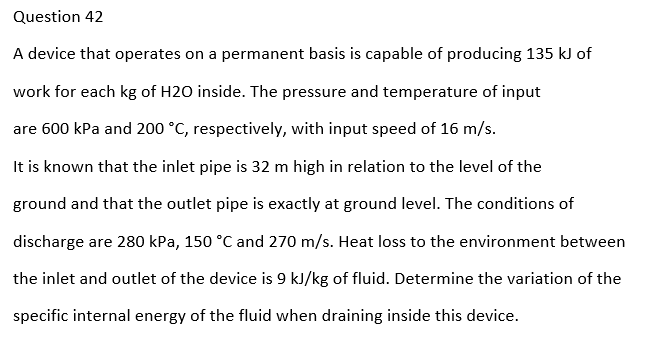A device that operates on a permanent basis is capable of producing 135 kJ of work for each kg of H2O inside. The pressure and temperature of input are 600 kPa and 200 °C, respectively, with input speed of 16 m/s. It is known that the inlet pipe is 32 m high in relation to the level of the ground and that the outlet pipe is exactly at ground level. The conditions of discharge are 280 kPa, 150 °C and 270 m/s. Heat loss to the environment between the inlet and outlet of the device is 9 kJ/kg of fluid. Determine the variation of the specific internal energy of the fluid when draining inside this device.
A device that operates on a permanent basis is capable of producing 135 kJ of work for each kg of H2O inside. The pressure and temperature of input are 600 kPa and 200 °C, respectively, with input speed of 16 m/s. It is known that the inlet pipe is 32 m high in relation to the level of the ground and that the outlet pipe is exactly at ground level. The conditions of discharge are 280 kPa, 150 °C and 270 m/s. Heat loss to the environment between the inlet and outlet of the device is 9 kJ/kg of fluid. Determine the variation of the specific internal energy of the fluid when draining inside this device.
Elements Of Electromagnetics
7th Edition
ISBN:9780190698614
Author:Sadiku, Matthew N. O.
Publisher:Sadiku, Matthew N. O.
ChapterMA: Math Assessment
Section: Chapter Questions
Problem 1.1MA
Related questions
Question
LIST 4

Transcribed Image Text:Question 42
A device that operates on a permanent basis is capable of producing 135 kJ of
work for each kg of H2O inside. The pressure and temperature of input
are 600 kPa and 200 °C, respectively, with input speed of 16 m/s.
It is known that the inlet pipe is 32 m high in relation to the level of the
ground and that the outlet pipe is exactly at ground level. The conditions of
discharge are 280 kPa, 150 °C and 270 m/s. Heat loss to the environment between
the inlet and outlet of the device is 9 kJ/kg of fluid. Determine the variation of the
specific internal energy of the fluid when draining inside this device.
Expert Solution
This question has been solved!
Explore an expertly crafted, step-by-step solution for a thorough understanding of key concepts.
Step by step
Solved in 2 steps

Knowledge Booster
Learn more about
Need a deep-dive on the concept behind this application? Look no further. Learn more about this topic, mechanical-engineering and related others by exploring similar questions and additional content below.Recommended textbooks for you

Elements Of Electromagnetics
Mechanical Engineering
ISBN:
9780190698614
Author:
Sadiku, Matthew N. O.
Publisher:
Oxford University Press

Mechanics of Materials (10th Edition)
Mechanical Engineering
ISBN:
9780134319650
Author:
Russell C. Hibbeler
Publisher:
PEARSON

Thermodynamics: An Engineering Approach
Mechanical Engineering
ISBN:
9781259822674
Author:
Yunus A. Cengel Dr., Michael A. Boles
Publisher:
McGraw-Hill Education

Elements Of Electromagnetics
Mechanical Engineering
ISBN:
9780190698614
Author:
Sadiku, Matthew N. O.
Publisher:
Oxford University Press

Mechanics of Materials (10th Edition)
Mechanical Engineering
ISBN:
9780134319650
Author:
Russell C. Hibbeler
Publisher:
PEARSON

Thermodynamics: An Engineering Approach
Mechanical Engineering
ISBN:
9781259822674
Author:
Yunus A. Cengel Dr., Michael A. Boles
Publisher:
McGraw-Hill Education

Control Systems Engineering
Mechanical Engineering
ISBN:
9781118170519
Author:
Norman S. Nise
Publisher:
WILEY

Mechanics of Materials (MindTap Course List)
Mechanical Engineering
ISBN:
9781337093347
Author:
Barry J. Goodno, James M. Gere
Publisher:
Cengage Learning

Engineering Mechanics: Statics
Mechanical Engineering
ISBN:
9781118807330
Author:
James L. Meriam, L. G. Kraige, J. N. Bolton
Publisher:
WILEY